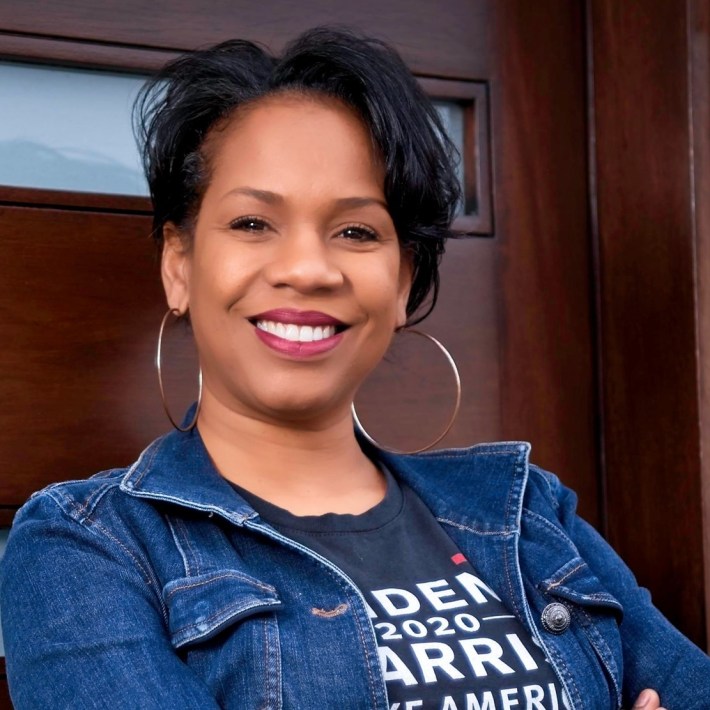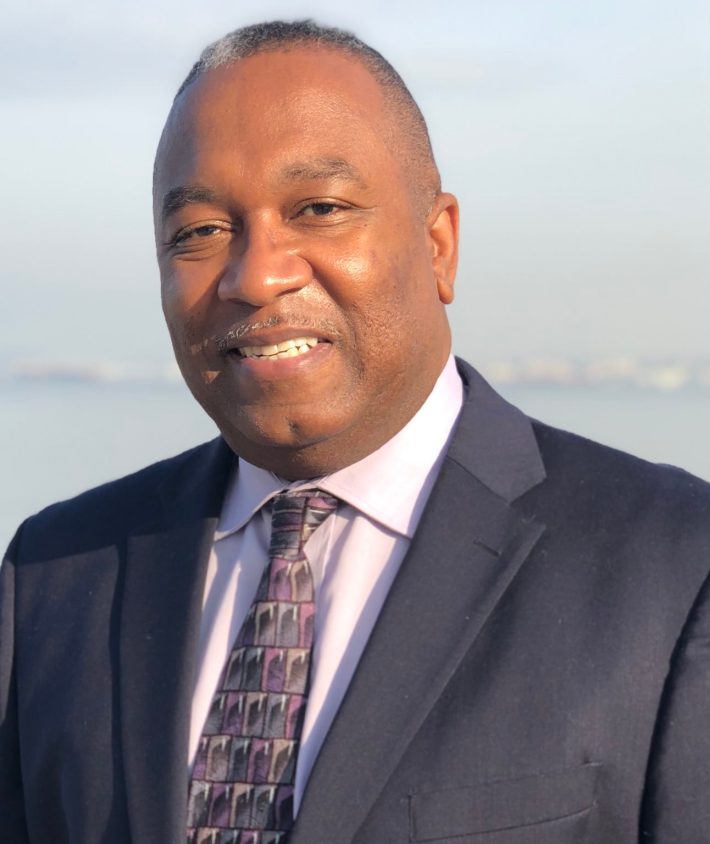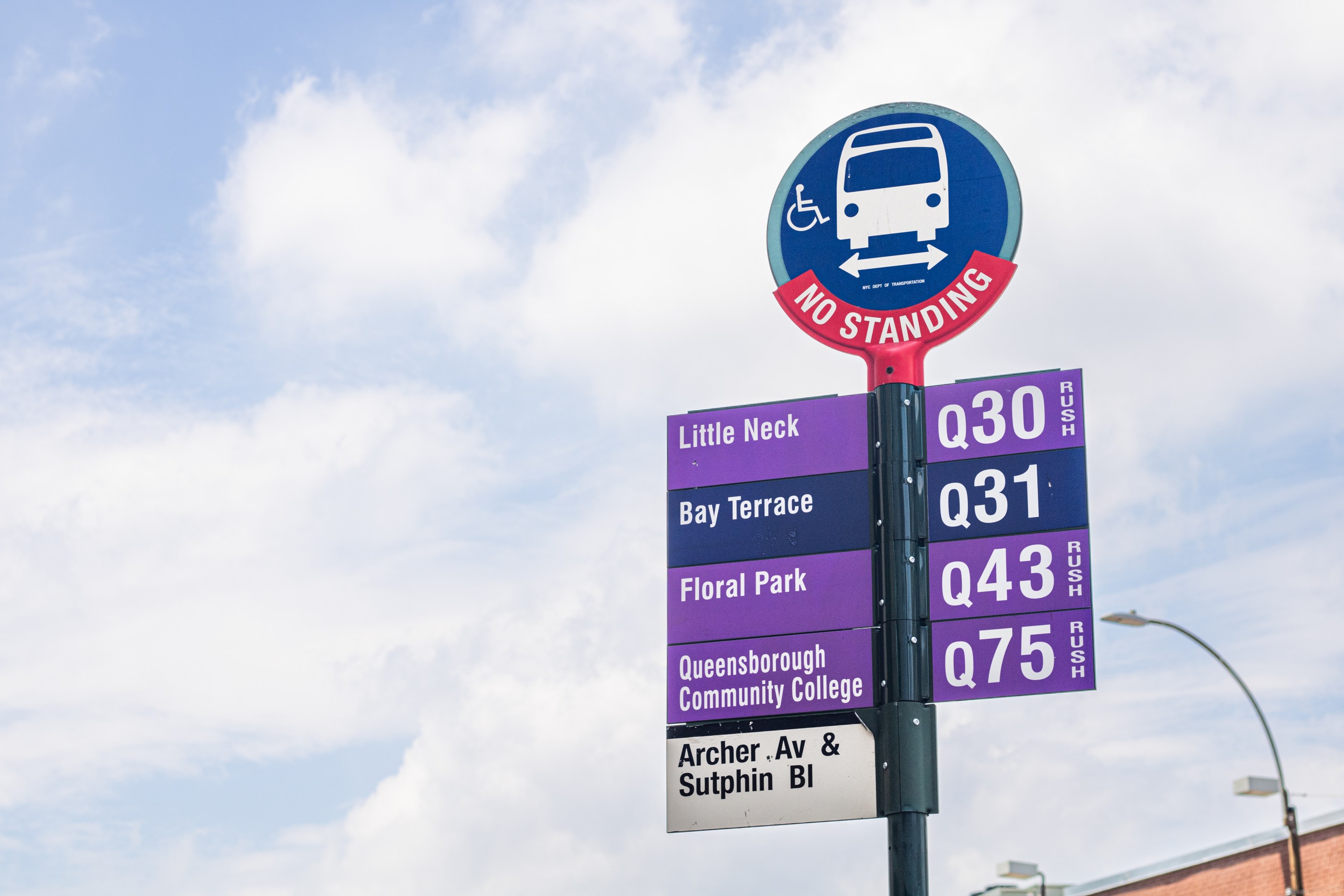Staten Island may be New York City’s Trumpiest borough, but that doesn’t mean it can’t elect a pro-bike, pro-pedestrian politician. Or does it?
The Rock has its share of problems when it comes to installing protected bike lanes (it has zero), bus-only lanes (the one on the Staten Island Expressway was converted to HOV after resident backlash, and then they still complained about it), speed humps (some there on bus routes called “speed cushions” allow cars to zip right over) or even intersection neckdowns (few and far between), and the No. 1 issue seems to be that a large numbers of voters are under the false impression that once they get behind the wheel of a car, they should be able to get wherever they are going as quickly as possible, everyone (and living thing — sorry, deer) be damned.
At least that’s what most of the candidates running for Richmond County’s three City Council seats seemed to worry about. Yes, they collectively said, there is a huge transportation problem on Staten Island, one that, along with the worst commute times to Manhattan in the tri-state area, includes too much speeding, distracted driving, crashes, injuries and deaths. But running a campaign on reducing traffic — and all the terrible things that comes with it (see previous sentence) — has them worried about finishing dead last in this year’s new ranked-choice voting system come the June 22 primary.
With that in mind, we reached out to all the potential council people to figure out for you, dear Streetsblog reader, which would-be lawmakers really have the gall, the nerve, and the audacity to make the tough decisions and push the plans that will surely change their constituents lives for the better — even if those constituents don’t know it yet.
District 49 (North Shore)
Number of reported crashes, April 2019 to April 2021: 3,889 (a bit more than five per day), injuring 77 cyclists (killing one), 229 pedestrians (killing three) and 1,140 motorists (killing four).

The island’s North Shore, which encompasses the third of the borough geographically closest to Manhattan and consisting of its most diverse population, has its best transportation system — mainly because just about every local bus line on the island begins or ends in St. George at the free Staten Island Ferry. Add to that the Staten Island Railway, which serves the ferry terminal along with three other North Shore stations — Tompkinsville, Stapleton, and Clifton. That system will be added to later this year when the city’s paid fast ferry service begins landing at a new dock adjacent to the St. George piers, providing faster service to Battery Park before heading to Midtown on the west side of Manhattan.
The North Shore was also home to the city’s first attempt at bike “sharing” on the island, when both Lime and Jump dropped off pedal-assisted two-wheelers in 2018. But that dockless pilot program expired in 2019 and, after a subsequent deal with Beryl fell through, islanders who want to bike have to buy their own.
Borough Hall and many of its city services offices are based in St. George, as well as a new, large courthouse just a few steps from the ferry, but most of the area is early-20th century suburban, featuring mostly single-family homes on streets that aren’t overly wide. Even the area’s main drags — Bay Street, Richmond Terrace, Victory Boulevard, Castleton Avenue, and Forest Avenue — are old roads that wind through business districts where on-street car storage is highly coveted. Some of those roads, including Victory — an old stage coach route that runs across the borough from Tompkinsville to Travis, where a ferry used to take passengers to Carteret, N.J. — were never widened, a fact some candidates wrongly think could be a way to alleviate traffic by widening roads.
The MTA is also considering what to do with the long-defunct North Shore passenger rail line, which closed along with a South Beach branch back in 1953. The right-of-way still exists — albeit with portions of it fallen into the Kill Van Kull, the tidal strait that separates Staten Island from New Jersey. One plan is to use the right of way for Bus Rapid Transit, a concept many of the candidates were high on.
Finally, the North Shore is also home to Staten Island’s — and the city’s — oldest bus lanes, running for about a mile along Victory Boulevard between Forest Avenue and Bay Street. The lane, which serves buses only between 6 and 10 a.m. in the northbound lane, and between 4 and 7 p.m. in the southbound lane, was one of the two installed by the city in 1963. But many candidates we spoke to weren’t sure how successful the lane was, citing the fact that didn’t hear many complaints about it or cheers for it.
We spoke with eight candidates seeking to replace term-limited Councilwoman Debi Rose for the 49th District seat. Here’s our what they had to say (in alphabetical order):

Amoy Barnes
Staffer at NYC Department of Education
Barnes called Staten Island’s lack of transportation its most important transportation issue, noting the city really needs to take advantage of the Rock’s shoreline to get people moving.
“Other boroughs are diversified, with Citi Bike, lots of buses and ferry service,” she said. “We have ‘Island’ in our name and we need to use the waterfront more.”
To that end, Barnes said she would call for an expansion of NYC Ferry service to far off North Shore neighborhoods, such as Mariners Harbor.
The self-described bicyclist said she would also like to create safer roads for pedal-pushers, and wants to Citi Bike brought to the forgotten borough, pointing out that just having more bicyclists on the roads will help cut down on crashes.
“We know that people drive safer when there are bicyclists around them,” she said. “I’ve seen what they’ve done in Brooklyn and Manhattan. Why can’t they do it here? Manhattan is the densest transportation city in the world. If they can do it there, why can’t we do it here?”
She said Victory Boulevard was an example of a main street that could have a protected bike lane installed — noting such a lane could weave in and out of both Silver Lake and Clove Lakes parks, which Victory abuts.
Barnes said she is against removing free on-street parking spaces to discourage driving in her district, but did not have a problem with red-light and speed cameras that keep drivers from getting too out of control.
“Look, nobody likes to get a ticket,” she said. “But it serves a purpose. It’s a habit changer. And with so many cars on the road, we need that.”
Barnes, who has received the StreetsPAC endorsement, added that she is a fan of roundabouts and other infrastructure improvements that slow down drivers by design, but all told said Staten Island drivers aren’t the worst in the city.
“Are there people that are impatient? They are few and far between,” she said. “The majority of Staten Islanders drive safely.”

Selina Grey
Political and community organizer for the New York State Nurses Association
Grey said all Staten Islanders — herself included — are way too dependent on cars to get around.
“I am guilty of that,” she said. “It takes way too long to get from one place to another on public transportation.”
But in order to solve that problem, Grey claims Islanders need more of it, citing its scarcity compared to the other boroughs as the Island’s No. 1 transit issue.
“When it comes to transportation, we are truly the forgotten borough,” she said. “And people will become less dependent if we have other options.”
What could those options be? Not the Bus Rapid Transit plan being studied by the MTA as a way to re-use the deactivated North Shore rail that has been out of service since 1953.
Instead, Grey would like to see a new light-rail system be put in along the route, with a connection over the Bayonne Bridge to the Hudson-Bergen line that terminates in Hoboken near the Path tunnel. And now would be the time to do it.
“The federal government is looking to spend on infrastructure. Staten Island isn’t ever a recipient of those funds,” she said. “We need to partner with other areas like Jersey so we would be better positioned to get the funding.”
But a simpler solution would be to add more routes to the city’s fast ferry service to get Islanders to places other than Manhattan.
“I would love to see the five-borough ferry take us to Queens or the Bronx,” she said.
Still, Grey didn’t want to push the envelope too far when it comes to getting that better public transportation in place. She said removing parking spaces in residential and commercial areas for things like Citi Bike docking stations wouldn’t go over well on the island.
“People scream for the hills about their parking,” she said. “Some families have two or three cars, and restaurants on Bay Street need places for people to park.”
She also questions the city’s intent when it comes to speed cameras, saying they are only installed to make money and, while they are fine around schools, they should not be everywhere — while admitting they reduce speeding.
“It’s a revenue generator for the city,” she said. “They have two on Morningstar Road, and they get you coming and going. It slows people down, but there isn’t even too much traffic there.”
As for Staten Island’s lack of protected bike lanes, Grey said many of the streets are not wide enough to accommodate them without removing parking spaces which, again, she is hesitant to do.
“I’m not sure people would want to lose all that parking for a bike lane,” she said. “Can we sensibly do it? I don’t know. It would have to be discussed.”

Kamillah Hanks
Chief Executive Officer at Historic Tappen Park Community Partnership
Hanks said she routinely hopped in her car to go to the bank around the block from her house, but when a bike-share program arrived on the Island, she changed her ways, using a bicycle to get around — and learning a lot along the way.
“Everyone should spend a day on a bike,” she said. “You quickly understand how wonderful it is, but also how dangerous it could be.”
That danger, she said, is the most important transportation issue on Staten Island.
“And after riding a bike around, I quickly became a better, slower, more attentive driver,” she said.
Hanks said speeding and the safety of pedestrians and bicyclists needs to play a bigger role in Staten Island’s continued development.
“People are not prioritizing cyclists and pedestrians, and their needs should be considered,” she said.
But on Staten Island, that takes a lot of convincing.
“People don’t see many bicyclists using a bike lane and they are like ‘No one is using it,’” she said. “But even if there are just two people using it, you have to protect them.”
Hanks said that protected bike lanes can be built on portions of Bay Street, Tompkins Avenue, Henderson Avenue, and Richmond Terrace, with the lanes weaving in and out of parks where they could.
The problem, she said, was convincing Islanders that it is the right thing to do.
“It is going to take a generation of cyclists,” she said. “I was never a person who considered using a bike. I didn’t think I’d like it. But after I started doing so, I loved it.”
Still, penalizing drivers by secretly ticketing speeders and red-light runners using cameras was not her preferred method to educate the public.
“When someone gets a speeding ticket, they don’t know about it for two weeks,” she said. “How does that slow people down. If you want them to slow down, let them know where the camera is.”
Hanks added she was a fan of bus lanes, noting that while they take up parking spaces, people on buses don’t seem to mind when they are quickly moving from one place to another. And she feared that only putting NYC Ferry docs on the North Shore would simply drive more traffic to the area, defeating the purpose.
“We’d have people driving here from the South Shore to catch the boat,” she said. “It would just bring more cars.”

John McBeth
Sr. Instructor at Con Edison
McBeth said the No.1 transportation problem on the North Shore is overcrowding and the tremendous amount of cars on the street, claiming a big step in solving the problem would be to end expensive studies and bring the North Shore and West Shore Bus Rapid Transit plans to fruition.
“Somebody is making a lot of money on these studies,” he said. “That plan needs to be ready to go, especially now that infrastructure projects are going to be funded. We’ve studied it to death.”
McBeth would also like to see an Island-wide bike-sharing program to help get people out of their cars.
“We should blanket the entire Island,” he said. “It would encourage more people to use them.”
But adding protected bike lanes to the Islands streets could be a problem based on the available space.
“Many of our streets simply aren’t wide enough,” he said. “If there are only two blocks on Van Duzer Street that are perfectly usable, well, that doesn’t add value. But where it is feasible, it should be done.”
McBeth noted that, while outside of the district, Richmond Avenue near the Staten Island mall has a bike lane safely off the street within the Freshkills Park.
“That really solves the problem,” he said.
He also believes there should be a bicycle lane over the Verrazzano-Narrows Bridge to Brooklyn, but it needs to be built out, and not take away a lane of traffic, as some are suggesting.
“Having it cantilevered on the outside is the best option,” he said.
McBeth admitted that it will be difficult to convince Islanders to remove parking spaces for better use — “Every single street space removal would be fought against,” he said — but said having spaces left empty during specific times for things like garbage storage is a step in the right direction.
“There are areas in St. George where we can create designated penned areas for trash pick-up so it doesn’t block the sidewalk,” he said. “You remove the parking spaces on pick-up days only.”
McBeth said he was in the middle on cameras enforcement, understanding it slows down drivers and save lives, but believing the false narrative it they can also cause accidents when drivers adversely react to them. Still, he said it is not unreasonable to get a ticket for going 10 miles per hour over the speed limit.
“That is not a little,” he said. “You are getting what you asked for.”

Troy McGhie
Teacher
McGhie said the problem of Staten Island’s overburdened roadways — the result of overdevelopment and a lack of thought on infrastructure — could be solved by looking to the water and providing ferry connections that presently don’t exist.
“It’s the most cost-effective way to move people around,” he said. “And it’s unconscionable that the new NYCFerry dock being constructed now replicates the Staten Island Ferry. We need another way to get to Brooklyn besides the bridge or going through Manhattan.”
McGhie said he would like to see more connections to Brooklyn to help many of his would-be constituents who work there now.
“If you are commuting to Brooklyn from Mariner’s Harbor, it takes an hour-and-a-half to get there,” he said. “We have to use the waterways to our advantage.”
But adding bike lanes to help share the road with cars — while they are sure to come in the future — will have to be rolled out slowly on Staten Island to be successful.
“We’ve got to take baby steps,” he said. “Staten Island is a very very car-oriented place. We need to create a safe system where bicyclists can use the roadways and still have the flow of traffic that we need. We need to reimagine the infrastructure and our roadways. This is done in other places. Bicyclists and cars share the roads. Go to places like Holland. They may have more bikes on the road than cars.”
Bus lanes, he added, are another thing that can work in the future, but in the meantime needs to take a back seat to cars, claiming the plan for bus rapid transit could be a folly.
“I don’t know if that is something that would work on the North Shore because we don’t have streets on the North Shore that have that lane capacity,” he said. “This is why I don’t know if a BRT would be successful.”
McGhie said he was a big fan of removing parking spaces for outdoor dining in front of restaurants, recommending it stick around as the pandemic comes to an end, but he wasn’t a huge fan the city’s speed camera program, calling it “a little bit of overkill.”
“Where we are today is not where speed cameras were envisioned,” he said. “We were supposed to have them by schools to slow traffic. Now, they are virtually everywhere. There are speed cameras placed in places that don’t make sense.”
He sighted College Avenue in Westerleigh as one of those places.
“The closest school is IS 51, and there is already a speed camera near there,” he said, noting that the speed of cars driving down the street could be controlled by stop signs or speed bumps. “That’s an out-of-place speed camera.”

Ranti Ogunleye
Cornerstone Director at the Gerard Carter Center of the Jewish Community Center
Ogunleye said an improved and beefed-up Staten Island Railway could go a long way to improving transportation on the Rock — and it is something that should have been done a long time ago.
“The train only goes from St. George to Tottenville,” he said. “What about St. George to Arlington so those residents can get to where they need to go?”
To that end, Ogunleye prefers the reactivation of the North Shore line over the creation of a bus rapid transit system along its right-of-way that is presently being considered by the MTA. To take it a step further, he says the same line should then be extended across the West Shore to Tottenville.
He also recommends creating fast ferry service along the North Shore to help get residents get to the city quicker.
“That is something that can begin now,” he said.
Ogunleye was a bit wishy-washy on speed cameras, saying they do make roads safer, but may be more about making the city money.
“I see how people speed in residential areas,” he said. “But sometimes it is used as a tool to bankroll the city, and in the process they start to break the backs of families struggling to get by.”
He claimed that today’s speed cameras are put in with little thought to safety, and more thought on increasing income.
“Near Hylan there are like two in a row, and that is not necessary,” he said “They should be spaced out and installed based on where the crashes are.”
As for getting some protected bike lanes on Staten Island, Ogunleye was for removing some parking spaces to make way for cyclists, even if it meant upsetting the voting public.
“Initially the neighborhood would get upset. But you have to reimagine,” he said. “They’ll thank us tomorrow.”

Kelvin Richards
Public Defender, Legal Aid Society
Richards said he has been trying to make the mean streets of Staten Island safer for years, advocating for — and helping get — speed humps installed to slow drivers down on streets surrounding the Park Hill Apartments on Vanderbilt Avenue.
That success mirrors his commitment to trying to make it easier to get from one place to another when Islanders choose to go somewhere without a car.
“When people are biking, you feel like you are going to be hit by a bus,” he said. “Remove parking to add bike lanes on streets where we have the tightest lanes.”
To that end, he says portions of Bay Street in Rosebank and Stapleton should be considered for those improvements along with other traffic-flow changes such as converting some two-way streets to one-ways.
Doing so would also improve bus travel times, which would in turn get more people on buses.
“If we had an effective bus route to the ferry, people will take the bus there instead of driving and looking for parking,” he said. “But those bus routes need to be made more efficient.”
Still, like most candidates, he thinks Staten Island’s infrastructure development up until this point — along with its citizen’s car-centric mentality — makes it harder for changes to arrive at this part of the city.
“It is set up as a suburb. We have a lot of cars. We don’t have subways,” he said. “Staten Island is built in a way people feel they have to use their car.”
That would change, he said, if the Island had a direct connection by train to the rest of the city.
“I envision the subway coming from Brooklyn to Staten Island. A train over the Verrazzano like the old one on the Brooklyn Bridge,” he said. “It is the forgotten borough because it is so hard to get here — and leave here.”
Michael Schnall
Owner, Empire Graphics

Schnall says Staten Island’s horrible commuting times is the “root of a lot of issues,” and is one of the reasons many islanders are not engaged with their government
“You can’t get to meetings at night if you get home at 8:30,” he said. “Then you spend the weekend catching up.”
To that end, Schnall says he would focus on other ways to get to and from work, including scooters and and e-bikes, and would like to see the island create an alternative transportation network for bicycles and the like through the borough’s many parks.
“The Greenbelt has 32 miles of trails, and we have a network of multiuser trails like the ones along Richmond Avenue near Travis Avenue and up to Latourette [golf course],” he said. “We need to connect those.”
He added that the Verrazzano-Narrows Bridge needs a bike lane.
“I’m thrilled there are now bike lanes on the Goethals and Bayonne Bridges,” he said. “We pay enough in tolls. They owe us a bike lane.”
But Schnall doesn’t think precious parking spaces should be replace with docking stations for CitiBike to get people out of their cars.
“You need to talk to the neighborhood,” he said. “I would not suggest a docking station in neighborhoods where parking is at a premium.”
Still, he said replacing street parking with outdoor dining areas could be beneficial.
“Removing the parking can make things better for business,” he said. “During the pandemic, no one complained. You had another amenity. People seemed OK with that.”
To help speed up buses, Schnall said enforcement of cars blocking the bus lanes on Victory Boulevard must be improved, and bus drivers should be given the ability to change the timing of traffic lights to help keep their vehicle — and the people in it — moving.
But he said other technologies to control traffic — like speed cameras — need to be rethought.
“The law was designed to slow down traffic, but the de Blasio Administration has used it to make money,” he said. “Any camera not performing in the spirt of the law should be removed.”
One such camera, he said, is on Clove Road facing away from nearby PS 35.
“That is a misuse of the camera,” he said. “It is punitive.”
Overall, Schnall said he understands that the car culture on Staten Island is bad for its residents, citing poor air ratings and the respiratory issues they are connected to. He thinks electric cars will help improve those things, but understands they won’t get people out of their vehicles — something he doesn’t see happing anytime soon.
“I’m not sure you can legislate away car culture,” he said.
In fact, he admits a car is a big part of his own identity, and it would take a lot to let it go.
“For me, a car is part of who I am,” he said. “But when it becomes more a burden than a blessing, I would get rid of it.”
District 50 (Mid-Island)
Number of reported crashes, April 2019 to April 2021: 3,381 (roughly four per day), injuring 49 cyclists (killing one), 200 pedestrians (killing five) and 1,390 motorists (killing three).

Republican Steven Matteo is giving up his seat to seek “higher” office, running for Borough President with the blessing of protege and current BP Jimmy Oddo. That should open up what eventually will be a three-person race between one of three Republicans (David Carr, Marko Kepi, and Sam Pirozzolo and Conservative, George Wonica — unless Wonica wins the Republican nod) against Democrat Sal Albanese.
StreetsPAC has not endorsed any candidate in those races, and efforts to speak with the frontrunner — Carr, who has the endorsement of Matteo — were unsuccessful. We did not speak with long-shot candidate Kepi, who has the endorsement of convicted felon and former Congressman Michael Grimm, as well as former Bay Ridge Brooklyn state Senator Marty Golden.
Pirozzolo stresses moving traffic faster above all else, as he thinks the amount of traffic on the Island is its biggest transportation issue. His “common sense, not nonsense” approach to traffic solutions has a windshield view of roads, claiming bike lanes are not a priority because very few people on Staten Island is crying out for them.
“We can’t just put in bike lanes because everyone else is doing it,” he said.
Still, he said he was once an avid bicyclist who may have been one of the last to ride over the old Goethals Bridge from Elizabeth, NJ to the Rock, back when an extremely old and run down pedestrian path was still accessible.
“I was in college. We did training over the Goethals,” he said. “You had to ride single-file, and there were holes in the sidewalk. The cops stopped us!”
Pirozzolo also has proposed adding turning lanes and building double-wide sidewalks for pedestrians and bicyclists along Rockland Avenue through the Island’s bucolic Greenbelt, noting that the heavily congested strip is unsafe for drivers, pedestrians and bicyclists alike.
Wonica said the most pressing transportation issue on Staten Island is the long commute to Manhattan, and recommended additional fast ferry service in Tottenville as well as on the East and West Shores of the Rock.
He called for the removal of all speed cameras that aren’t near schools, claiming they are “nothing more than a fund-raising opportunity for the city and the state,” and said those around schools should only be on when school is in session.
Democrat Albanese, a perennial mayoral candidate who was once the councilman from Bay Ridge, said much of Staten Island’s traffic issues would be solved if the city and state finally built a subway tunnel to Brooklyn from the North Shore, and now is the time to do it thanks to the the huge infrastructure bill President Biden will likely pass.
“The city needs to be ready with shovel-ready projects,” he said. “It’s about time we get serious about it.”
He also proposed removing the $6.75 bus fare for those using express bus service to Manhattan, claiming it would go a long way to getting people on board.
“Staten Islanders need accessible, safe, and cheap mass transit,” he said. “People will jump on an express bus if it is free.”
District 51 (South Shore)
Number of reported crashes, April 2019 to April 2021: 2,508 (more than three per day), injuring 37 cyclists, 119 pedestrians and 926 motorists (killing five).

Joe Borelli is not facing a primary challenge on the Trump-happy South Shore, and will face off against newcomer Olivia Drabczyk in the November election. StreetsPAC has not endorsed yet.
For her part, Drabczyk said money generated by speed cameras should be use to fund improvements on the streets, such as the installation of sidewalks on narrow Arthur Kill Road, a major South Shore artery in what she called a transit-starved area.
“We should not be thrown off a bus into the middle of a dirt path,” she said.
The election is on June 22. Early voting began on June 12. Click here for more information.






